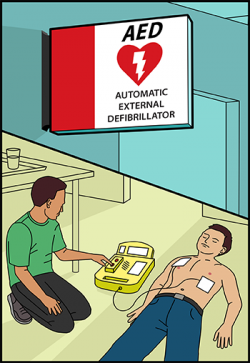
 You're eating lunch in a local mall when a man at the next table collapses.
You're eating lunch in a local mall when a man at the next table collapses.
Your first move? If you see a person collapse like that, someone who is not responsive and not breathing normally, you should first call 911 and then start cardio-pulmonary resuscitation (CPR). But the next step is to look for the nearest AED and use it on the spot. If the man is in cardiac arrest, you just may save his life.
AEDs are special defibrillators that even minimally trained bystanders can use. A defibrillator is a device that delivers an electrical shock to restore the heart's normal rhythm. AEDs are medical devices regulated by the Food and Drug Administration (FDA). As part of its regulatory oversight, FDA closely monitors reports of device malfunctions from both consumers and the manufacturers themselves. AEDs can be found in many public places, including offices, schools, shopping malls, grocery stores and airports.
Sudden cardiac arrest is a leading cause of death in the U.S. Each year, emergency medical services treat about 383,000 victims of sudden cardiac arrest before they reach the hospital, according to the American Heart Association. Less than 12% of those victims survive.
Sudden cardiac arrest can happen to anyone, at any time. Some people with underlying cardiac conditions can be at a higher risk of sudden cardiac arrest. Unlike heart attacks, caused by a blockage that stops blood flow to the heart, sudden cardiac arrest is caused when the heart's electrical system malfunctions, producing abnormal heart rhythms (called arrhythmias), according to Oscar Tovar-Calderon, M.D., a medical officer at FDA. Signs of cardiac arrest include sudden collapse and immediate loss of consciousness.
If you see a person collapse like that, and another person is nearby, one can start CPR and the other can look for an AED, says Tovar-Calderon.
"Defibrillation is a time-sensitive issue," he notes. The probability of survival decreases by 7% to 10% for every minute that a victim stays in arrhythmia. If for any reason a needed shock is not delivered, he says, someone near the stricken person should continue CPR until an emergency responder can take over.
How Do AEDs Work?
AEDs use electrical shocks to restore the heart to its normal rhythm. The devices provide verbal directions to the user. This is how they work:
- Two sticky pads with sensors (called electrodes) are attached to either side of the chest of the person in cardiac arrest.
- The electrodes send information about the person's heart rhythm to a computer in the AED, which then analyzes the rhythm to find out whether an electric shock is needed.
- The AED uses voice prompts to instruct someone how to attach the electrodes and when to press a button to deliver the shock. In some devices, the voice prompts announce that a shock is going to be delivered and the AED delivers the shock without intervention by the user.
Some people may be afraid to use an AED because they're concerned that something may go wrong and they might be sued. However, most states' Good Samaritan laws and the Federal Cardiac Arrest Survival Act (Public Law 106-505) provide some protection for bystanders who respond to emergencies.
People who have been diagnosed with a heart condition and are most at risk for sudden cardiac arrest may want to consider buying an AED for use at home and should discuss this with their healthcare professional, says Tovar-Calderon. FDA has cleared AEDs that can be used at home. One device has been cleared for over-the-counter use, while all other AEDs require a prescription.
Where to Get AED Training
AEDs are not difficult to use, but training in the use of AEDs is highly recommended. Such training—frequently in connection with CPR training—is offered by major health organizations, such as the American Heart Associationand the American Red Cross, as well as from a number of private companies. Some training is available online. Classes teach such skills as how to recognize the signs of a sudden cardiac arrest, when to alert emergency medical services, how to do CPR, and how to use an AED.
Consumers can help FDA detect possible issues with AEDs by alerting the agency to any problems encountered with the devices through its MedWatch adverse event reporting program.
See attachment.
SOURCE: FDA
| Documents | Size |
|---|---|
| fda_consumer_news_on_aeds.pdf | 94.41 KB |
